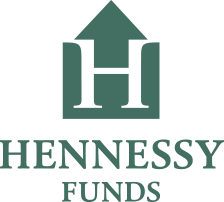A Closer Look at the Fund's "Best Ideas" Portfolio
The Portfolio Managers of the Hennessy Focus Fund discuss changes made to the portfolio in the first quarter of 2025, a new fund position, and insights into several holdings.
-
 David Rainey, CFACo-Portfolio Manager
David Rainey, CFACo-Portfolio Manager -
 Ira Rothberg, CFACo-Portfolio Manager
Ira Rothberg, CFACo-Portfolio Manager -
 Brian Macauley, CFACo-Portfolio Manager
Brian Macauley, CFACo-Portfolio Manager
Key Takeaways
» In volatile markets, we try to tune out the macro noise and instead focus on the quality of the businesses we own, their returns on capital and their growth runways.
» In the first quarter of 2025, the Fund exited Warner Music, added RELX Group, and rebalanced existing holdings.
» As April 2025, the Fund offered a lower valuation with a higher expected growth rate versus the Russell 3000 Index.
» We believe the Fund has relatively little exposure to businesses likely to suffer direct negative impact from an increase in tariffs. Many holdings in the Fund are service-oriented or focused on domestic operations, which should provide insulation from direct tariff impacts.
Given the uncertainty around trade policies, inflation, and consumer sentiment, how have you navigated the increased market volatility in 2025?
With a new Administration and a new Congress come new priorities. There is raging debate about both short- and long-term consequences of new tariffs, promulgated by the Trump Administration, on both consumer prices and inflation. At the same time Congress is faced with sunsetting, renewing or recalibrating the personal tax cuts ending this year as well as reprioritizing spending and managing the Federal government’s budget deficit.
As long-term, business-model focused investors we try and tune as much of this macro noise out of our heads and turn to what is important. We focus on the quality of the businesses we own, their returns on capital and the growth runways in front of them.
It is not in our DNA to chase macro developments or to position the Fund to profit from temporary upside or downside volatility.
Our goal is to earn a mid-teen, compounded rate of return across the portfolio’s holdings, realizing that some names will be below and some above this yardstick. In any given year there will be stock volatility for a variety of reasons and we hope over time to selectively capture some of these downside price movements when we add new positions and selectively enlarge existing holdings.
What changes were made to the portfolio in 1Q25? Please discuss what factors led you to sell a holding or reduce a weighting in a holding?
During the first quarter we exited Warner Music Group and used those proceeds to purchase a new position in RELX Group plc. While this was only a small change—about 0.5% of assets—it reflects our waning conviction in our Warner thesis, and new appreciation for the RELX investment case (discussed in more detail later).
We also used mutual fund flows during the period to rebalance existing holdings, reducing our weighting in CarMax, American Tower, Markel, Aon, O’Reilly and Encore Capital Group, while increasing our weight in AST SpaceMobile, Cogent, Ashtead Group, Brookfield Corporation, NVR, Shentel, Applied Materials, and TransDigm. There is no significant change in our thinking about these holdings, this was simply a rebalancing at the margin to reflect our current best judgment.
Would you please discuss a portfolio holding that has exceeded expectations with respect to earnings in 2024?
Last year was a banner year for Fund holding TransDigm Group Inc, (TDG) returning over 32% inclusive of a $75 per share special dividend. TransDigm is a leading designer, producer, and distributor of highly engineered aircraft component parts, systems and subsystems that are critical original equipment manufacturers (OEM) as well as aftermarket replacement parts necessary for the safe and effective operation of aircraft worldwide.
Rewinding the clock back to November 2023, consensus Street EPS estimates for TransDigm were $32.31 for FYE 2024 and $37.55 for FYE 2025. During 2024 TDG consistently met revenue growth expectations and materially beat on profitability, leading to actual 2024 FYE earnings of $33.93 or 5% better than initial consensus estimates at the beginning of the year. During 2024 the Street also raised its consensus FYE 2025 EPS estimates 3.8% from $37.55 to $39.01.
Throughout 2024, expectations for new commercial aircraft production as well as rebounding domestic and international travel drove accelerating demand for both OEM and maintenance/repair related aftermarket replacement parts resulting in a strong business environment for TransDigm and growing earnings expectations.
Would you please discuss a new holding to the Fund?
Early in the first quarter we established a position in RELX Group plc. RELX is a global provider of information-based analytics and decision tools for professional and business customers. We believe RELX presents a compelling investment opportunity, particularly within its Legal segment. The Legal segment, with its LexisNexis offering, has demonstrated strong underlying organic revenue growth. Growth in the legal segment accelerated to 7% in 2024 from 6% in 2023. This growth is significantly fueled by the strategic incorporation of artificial intelligence (AI) through products like Lexis+, Lexis+ AI. Its recently introduced Protégé product should help extend this growth runway. These AI-powered tools are designed to enhance lawyer productivity by offering features such as conversational search, intelligent legal drafting, and insightful summarization, addressing the core needs of speed, accuracy, and cost-effectiveness. RELX’s established global platform and extensive collection of trusted legal content provide a significant advantage in delivering high-quality, citation-backed AI solutions.
RELX’s diverse portfolio across risk, scientific, technical, medical, and exhibitions sectors provides diversification and resilience. CEO Erik Engstrom is highly capable and has successfully led RELX through a significant transformation from a traditional publishing company to a leading provider of information-based analytics and decision tools. With a clear strategic focus on increasing the utility of the company’s unique data sets with AI, a capital-light business model, and a commitment to returning value to shareholders, RELX is well-positioned for low-teens compounding of EPS over the next five years.
Would you please discuss the top contributors and detractors of performance in 1Q25?
Leading contributors during the quarter included O’Reilly Automotive, up 21%, American Tower, up 19%, and Aon, up 11%. These businesses have enjoyed good recent fundamental performance, but their stock prices have also benefited from the businesses being relatively acyclical in an increasingly uncertain macro-economic environment. O’Reilly, in particular, appears well positioned in this environment since leaders in the aftermarket auto parts business have demonstrated an ability to use higher input costs from tariffs to increase prices and drive profits higher.
Leading detractors during the quarter include RH, down 40%, Cogent Communications, down 19%, and Encore Capital Group, down 28%. RH, in particular, had a difficult quarter because of lower-than-expected FY25 guidance, excess inventory, and perceived vulnerability to rising tariffs. RH imports nearly all its home furnishing products, with about 70% coming from Asia. At the current proposed tariff rates, we think RH will need to raise prices 3% to 5% to offset higher input costs and preserve its profitability. We believe this may dampen some demand but we still expect healthy revenue and profit growth this year. Encore Capital traded down with the release of its fourth quarter results (reported in Q1) due to reduced expectations for its European business. And finally, Cogent Communications sold off with a slower than expected ramp in wavelength sales. We continue to have a positive outlook for the company’s wavelength opportunity, and expect it to build a sizable and very profitable new business line here in the coming years.
Brookfield is one of the world’s largest investors in infrastructure assets. What does the company see that makes them optimistic about the infrastructure opportunity?
Brookfield often discusses three major secular trends they are capitalizing on in their infrastructure business. They refer to these as the “3 Ds”— Digitization, Decarbonization, and Deglobalization.
Digitization refers to the growing digital nature of the economy, including ecommerce, video streaming, and AI. Brookfield is a major owner and operator of data centers globally, with additional capital earmarked for further growth. It is also an owner and operator of cell phone towers around much of the world—a further play on wireless information flow.
Decarbonization refers to the gradual phasing out of fossil fuels as a source of energy in a global economy. Brookfield is well positioned here as one of the largest owners and operators of hydroelectric, wind, and solar farms in the world. Brookfield continues to invest in this network to expand capacity while displacing high carbon energy sources with low carbon renewable sources. The growth opportunity and return potential here remain large and attractive.
Finally, Deglobalization refers to the nearshore and re-industrialization of manufacturing in the U.S. and other developed markets. Covid laid bare the supply chain vulnerabilities that many countries have as a result of decades of outsourcing, and we are embarking on a large-scale re-engineering of those supply chains. This requires significant investment in upgrading ports, roads, railroads, and manufacturing facilities, all of which Brookfield has a hand in financing and owning. President Trump’s recent tariff enactment serves to further accelerate this global trend.
These are powerful secular forces that seem likely to persist for the next decade or more. This is one reason we favor Brookfield over other alternatives managers, and believe that they have a long runway for growth in front of them.
How have weather events and the California fires impacted Markel Group’s business model and revenue?
Markel Group (MKL) is a diversified financial holding company powered by a specialty insurance business whose decades of profitable underwriting has allowed the company to fund substantial investments in both public and private businesses.
During 2024, hurricanes on the East Coast ravaged the shorelines and widespread wildfires in California scorched more than a million acres.
Markel’s hurricane losses came in less than expected, ultimately incurring $71mm of combined storm losses during the year representing about 1 point of earned premium. The California loss estimates are between $90mm to $130mm today. We view this range as conservative because it contains no provision for potential salvage and subrogation recoveries. Markel’s largest exposures are in policies written to insure fine art and collectibles.
At this point we expect their total catastrophe losses to be between 1 to 3 points of earned premium, an amount unlikely to change the company’s appetite for this type of specialty insurance nor have any impact on their coverages or business model. Even with these cat losses Markel’s combined ratio came in at 95.2% representing another year of consistent profitability and growth in intrinsic value for shareholders.
Would you provide an update of the Fund’s largest holding, AST SpaceMobile?
The last six months were transformational for AST SpaceMobile. They fortified their balance sheet with a $460mm convertible senior note offering, and as part of this transaction, AT&T, Google, Verizon, and Vodafone converted their existing notes into class A shares. With $1bb of proforma cash, AST accelerated its satellite manufacturing production plans from 17 to 40 fully integrated Block 2 BlueBirds (B2BBs) and began the procurement of long lead items for another 13 satellites.
Additionally, they began packaging their application-specific integrated circuit (ASIC) chips with the goal of rolling them into production in the second half of 2025 and exercised contract options to secure launch services for approximately 60 satellites during 2025 and 2026. The company reiterated their guidance they could achieve operating cash flow breakeven when they provide intermittent service with 25 satellites. We believe they should be nicely profitable with the launch of 60 B2BBs which should support continuous service in the U.S., Europe, and Japan by the end of 2026.
Further, in partnership with debt holders of the bankrupt Ligado, AST signed an agreement which will provide them with long-term access to up to 45 MHz of lower mid-band spectrum in the U.S. and Canada which they can use in concert with their mobile network operator (MNO) partner’s spectrum holdings.
The first five B1BBs are fully operational and performing as expected. On the government front, AST secured an additional contract with the U.S. Space Development Agency for $43mm of revenue to provide satellite services through a prime contractor. This represents their fifth US government contract award and reinforces communications and non-communications capabilities of the satellites.
Finally, AST expanded its manufacturing footprint with facilities in Spain and South Florida, extended its partnership with Vodafone for another ten years and entered into a joint venture (JV) with Vodafone in Europe to create a “jointly-owned European satellite service business to serve MNOs in European markets.” We are excited about this JV because it preserves AST’s economics, solves for European sovereignty issues, and could lead to additional mid-band spectrum opportunities.
We are quite pleased with these developmental highlights and remain excited about the future.
What are the current earnings growth rates and valuations for the Fund vs. the Russell 3000 Index?
As of the beginning of the second quarter of 2025, the Fund offered a lower valuation with a higher expected growth rate versus the benchmark Index. The Fund’s expected 2026 earnings per share growth rate was 15.9% and the Fund was trading at a priceto-earnings (P/E) multiple of 17.0x. By comparison, the Russell 3000 Index, a proxy for the broad equity market, has earnings growth expectations of 15.2% with a P/E multiple of 18.0x.
How could tariffs affect the Fund’s holdings?
We believe the Fund has relatively little exposure to businesses that are likely to suffer direct negative impact from an increase in tariffs. The lion’s share of the portfolio is invested in businesses that are service-oriented or focused on domestic operations, which should provide insulation from direct tariff impacts.
For example, Brookfield Corporation invests in infrastructure within countries, rather than engaging in cross-border trade. AST SpaceMobile has a service-based revenue model providing a space-based cellular broadband network to global mobile network operators. The company is vertically integrated and builds its satellites in the United States. O’Reilly Automotive benefits from tariffs because higher import duties on new vehicles discourage car purchases, leading consumers to repair older vehicles instead, which boosts demand for auto parts. Aon Plc, a global professional services firm focused on insurance brokerage, risk management, and consulting, does not manufacture or trade physical goods subject to tariffs. Markel Group, as a specialty insurance and investment holding company, has minimal direct exposure to tariffs.
These holdings provide support for our view that the portfolio is relatively well insulated from direct tariff impact.
- In this article:
- Domestic Equity
- Focus Fund
You might also like
-
 Portfolio Perspective
Portfolio Perspective
Focus FundFrom Rate Cuts to AI: Positioning the Portfolio for Potential Opportunity
 David Rainey, CFACo-Portfolio Manager
David Rainey, CFACo-Portfolio Manager Ira Rothberg, CFACo-Portfolio Manager
Ira Rothberg, CFACo-Portfolio Manager Brian Macauley, CFACo-Portfolio ManagerRead the Commentary
Brian Macauley, CFACo-Portfolio ManagerRead the CommentaryThe Portfolio Managers discuss holdings that could potentially benefit from lower rates, tariffs, and artificial intelligence (AI). The team also provides an update on AST SpaceMobile and discusses potential opportunities in select Technology and Health Care companies.
-
 Company Spotlight
Company Spotlight
Focus FundO’Reilly Automotive—Revved for Growth
 David Rainey, CFACo-Portfolio Manager
David Rainey, CFACo-Portfolio Manager Ira Rothberg, CFACo-Portfolio Manager
Ira Rothberg, CFACo-Portfolio Manager Brian Macauley, CFACo-Portfolio ManagerRead the Spotlight
Brian Macauley, CFACo-Portfolio ManagerRead the SpotlightO’Reilly Automotive is a leader in the automotive aftermarket parts industry in the U.S. The company’s scale, unique distribution infrastructure, and customer service-oriented culture should allow it to take market share in a fragmented U.S. market for years to come.
-
 Portfolio Perspective
Portfolio Perspective
Cornerstone Mid Cap 30 FundPortfolio Drivers: Consumer Discretionary and Industrials
 Neil J. HennessyChief Market Strategist and Portfolio Manager
Neil J. HennessyChief Market Strategist and Portfolio Manager Ryan C. Kelley, CFAChief Investment Officer and Portfolio Manager
Ryan C. Kelley, CFAChief Investment Officer and Portfolio Manager L. Joshua Wein, CAIAPortfolio ManagerRead the Commentary
L. Joshua Wein, CAIAPortfolio ManagerRead the CommentaryCornerstone Mid Cap 30 Fund Portfolio Managers Ryan Kelley and Josh Wein review the Fund’s investment strategy, discuss the most recent rebalance, and highlight the recent change in market cap range of potential investments.
